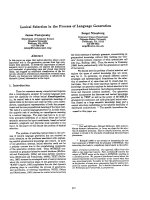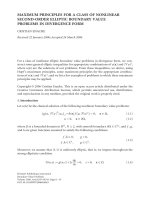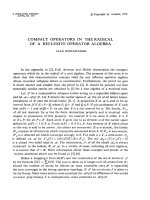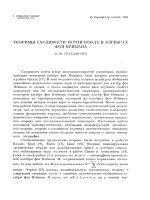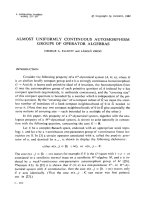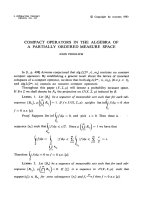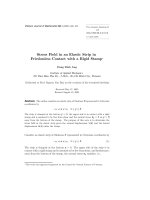Báo cáo toán học: "Maximum matchings in regular graphs of high girth" ppt
Bạn đang xem bản rút gọn của tài liệu. Xem và tải ngay bản đầy đủ của tài liệu tại đây (79.58 KB, 4 trang )
Maximum matchings in regular graphs of high girth
Abraham D. Flaxman
Microsoft Research
Redmond, Washington, USA
Shlomo Hoory
IBM Research Laboratory
Haifa, Israel
Submitted: April 22, 2006; Accepted: Dec 10, 2006; Published: Jan 3, 2007
Mathematics Subject Classification: 05C70
Abstract
Let G = (V, E) be any d-regular graph with girth g on n vertices, for d ≥ 3. This
note shows that G has a maximum matching which includes all but an exponentially
small fraction of the vertices, O((d − 1)
−g/2
). Specifically, in a maximum matching
of G, the number of unmatched vertices is at most n/n
0
(d, g), where n
0
(d, g) is the
number of vertices in a ball of radius (g − 1)/2 around a vertex, for odd values of g,
and around an edge, for even values of g. This result is tight if n < 2n
0
(d, g).
1 Introduction
For a graph G, a matching (or one-factor) of G is a subgraph of G in which each vertex has
degree at most one. A basic question in combinatorial optimization is, “What is the size of a
maximum matching in a given graph?” This has been explored extensively as an algorithmic
question, and a number of efficient procedures are known which find a maximum matching
of a given graph. This note considers the question from a different angle. What general
graph properties imply that a graph must contain a large matching? This note shows that
in regular graphs, high girth is such a property.
The notation used in this note is collected in this paragraph. For the graph G = (V, E)
and u, v ∈ V , write u ∼ v if and only if {u, v} ∈ E, and abbreviate {u, v} with uv when it
is clear from context that this refers to an edge. For S ⊆ V , write G[S] to denote the graph
G induced by the vertices S, and write E[S] to denote the edges in G[S]. The girth of a
graph G is the length of the shortest cycle in G. When dealing with a different graph, say
H, write V (H) to denote the vertex set of H, and E(H) to denote the edge set. Finally, say
that G is a (d, g)-graph if it is a d-regular graph of girth at least g.
the electronic journal of combinatorics 14 (2007), #N1 1
Theorem 1 Let G be a (d, g)-graph on n vertices and d ≥ 2. Then G contains a matching
with at most n/n
0
(d, g) unmatched vertices, where
n
0
(d, 2r + 1) = 1 + d
r−1
i=0
(d − 1)
i
,
n
0
(d, 2r) = 2
r−1
i=0
(d − 1)
i
.
Theorem 1 shows that for d-regular graphs with fixed d ≥ 3, the fraction of unmatched
vertices in a maximum matching is exponentially small in the girth of the graph. For 2-
regular graphs (which is to say, collections of disjoint cycles) the fraction of unmatched
vertices tends to 0 like 1/g.
The bound in the theorem is tight in some cases. To argue this requires some background
information. Let n(d, g) be the least number of vertices in a (d, g)-graph. The simplest lower
bound on n(d, g) is the Moore bound, which states that n(d, g) ≥ n
0
(d, g). It can be derived
by a counting argument based on the fact that a ball of radius
g−1
2
around a vertex is a
tree (or a ball around an edge, depending on the parity of g) [3, Proposition 23.1, p. 180].
Although significant effort has been invested in improving this lower bound, the best known
bound is still n
0
(d, g) + c for some small additive constant (see [3, Theorem 23.6, p. 185],
and the survey [9]). On the other hand, the best upper bound on n(d, g) is on the order of
n
0
(d, g)
3/2
, and is achieved by several constructions [7, 8, 6]. Establishing better asymptotic
bounds on n(d, g) is a well known open question.
That Theorem 1 is tight for certain values of (d, g) can be seen as follows. The theorem
implies that a (d, g)-graph G of size n < 2n
0
(d, g) has at most one unmatched vertex.
Therefore, since the number of unmatched vertices must have the same parity as n, this
result is tight. In particular, if n is even, then the graph has a perfect matching. As
mentioned previously, it is not known if there are pairs (d, g) such that n(d, g) < 2n
0
(d, g)
for d ≥ 3 and large g. However, there are abundant examples of such (d, g)-graphs for small
values of g. It is worth mentioning that a result of [1] implies that under the same conditions
the graph G is an expander. Namely, for any integers d ≥ 3 and g and a graph G satisfying
n(d, g) < 2n
0
(d, g), the second largest eigenvalue of the adjacency matrix λ(G) is smaller
than d − for some = (d, g) > 0.
The proof of Theorem 1 is a simple combination of the correct ingredients. One ingredient
is the characterization of the matching polytope due to Edmonds [5]. (See also the recent
survey by Cunningham for several different proofs and a historical discussion [4].)
Theorem 2 (Edmonds, 1965) The set of incidence vectors of the matchings of G have a
convex hull which is equal to the polytope containing all x ∈ R
E
which satisfy the following
the electronic journal of combinatorics 14 (2007), #N1 2
three conditions:
w : v∼w
x
vw
≤ 1, for all v ∈ V ; (1)
e∈E[S]
x
e
≤
|S| − 1
2
, for all S ⊆ V with |S| odd; (2)
x
e
≥ 0, for all e ∈ E. (3)
Another ingredient is the generalization of the Moore bound to irregular graphs, due to
Alon, Hoory, and Linial [2]. As stated before, the original Moore bound applies to regular
graphs only and states that n(d, g) ≥ n
0
(d, g).
Theorem 3 (Alon, Hoory, and Linial, 2001) The number of vertices n in a graph of
girth g and average degree d ≥ 2 satisfies
n ≥ n
0
(d, g).
With these theorems in hand, it is a simple matter to verify that a point z ∈ R
E
, which
will be specified explicitly in the next section, lies within the matching polytope. Since the
extreme points of the matching polytope are integral, this shows that there is some integral
solution to the LP which corresponds to a matching with at least as many edges as the
weight of z.
2 Proof of Theorem 1
For d = 2, the theorem states that the portion of unmatched vertices is at most 1/n
0
(d, g) =
1/g. The result in this case follows by observing that G is a collection of cycles of length
at least g, and each cycle has at most one unmatched vertex in a maximum matching.
Henceforce, consider the degree d to be at least 3.
Consider the point z = (z, . . . , z) ∈ R
E
. Then z is in the matching polytope if 0 ≤ z ≤ 1/d
and for every vertex set S of odd size
z · |E[S]| ≤
|S| − 1
2
. (4)
Let d
S
= 2|E[S]|/|S| denote the average degree of the subgraph G[S]. If d
S
< 2 then
|E[S]| ≤ |S| − 1 which yields the required inequality. So assume that d
S
≥ 2 and rewrite (4)
as:
z ≤
|S| − 1
d
S
· |S|
.
The right hand side of the inequality is increasing as a function of |S|, so, by Theorem 3, for
the inequality to hold, it is sufficient to take z to be the minimum of f(δ) where 2 ≤ δ ≤ d
and
f(δ) =
n
0
(δ, g) − 1
δ n
0
(δ, g)
.
the electronic journal of combinatorics 14 (2007), #N1 3
It is shown below that f(δ) is monotone decreasing for δ ≥ 2, so that the minimum is
attained by δ = d. Therefore there is a matching of size at least the weight of z, which is
f(d) ·
nd
2
=
1 −
1
n
0
(d, g)
·
n
2
,
as claimed.
It remains to show that f(δ) is monotone decreasing for δ ≥ 2, i.e.
f
(δ) =
d
dδ
1
δ
−
1
δ n
0
(δ, g)
≤ 0.
This is equivalent to
n
0
(δ, g) + δn
0
(δ, g) ≤ n
0
(δ, g)
2
. (5)
Since n
0
(δ, g) is a polynomial of degree r = (g −1)/2 in δ−1 with non-negative coefficients,
then (δ − 1)n
0
(δ, g) ≤ rn
0
(δ, g) for all δ ≥ 2. Therefore
n
0
(δ, g) + δn
0
(δ, g) ≤ n
0
(δ, g) + 2(δ − 1)n
0
(δ, g) ≤ (2r + 1)n
0
(δ, g) ≤ gn
0
(δ, g) ≤ n
0
(δ, g)
2
,
which verifies that inequality (5) holds. This proves the monotonicity of f(δ) in the required
range, and completes the proof of the theorem.
✷
References
[1] A. Alon, S. Hoory, N. Linial, A Continuous Analogue of the Girth Problem, Journal of
Combinatorial Theory Series B 84(2), p.340-363, 2002.
[2] N. Alon, S. Hoory, N. Linial, The Moore bound for irregular graphs, Graph and Com-
binatorics 18(1), p.53-57, 2002.
[3] N. Biggs, Algebraic Graph Theory, Cambridge University Press, Cambridge, 2nd Ed.
(1993).
[4] W. H. Cunningham, Matchings, matroids, and extensions, Math. Program., Ser. B, 91
(2002) 515-542.
[5] J. Edmonds, Maximum matching and a polyhedron with 0, 1 vertices, J. Res. Nat. Bur.
Standards Sect. B 69, 125-130.
[6] F. Lazebnik, V. A. Ustimenko, A. Woldar, A new series of dense graphs of high girth,
Bull. Amer. Math. Soc. (New Series), 32 issue 1 (1995), 73–79.
[7] A. Lubotzky, R. Phillips, P. Sarnak, Ramanujan graphs, Combinatorica 8 issue 3 (1988).
261–277.
[8] G. A. Margulis, Explicit group-theoretic constructions of combinatorial schemes and
their applications in the construction of expanders and concentrators, Probl. of Inform.
Trans., 24 issue 1 (1988),39–46.
[9] P. K. Wong, Cages—a survey, J. Graph Theory 6 (1982), 1–22.
the electronic journal of combinatorics 14 (2007), #N1 4
